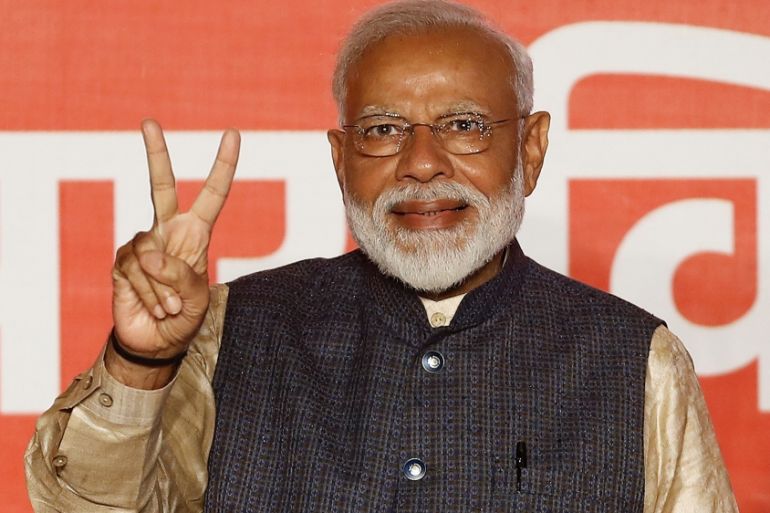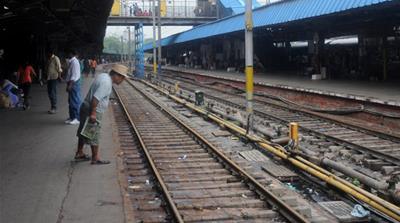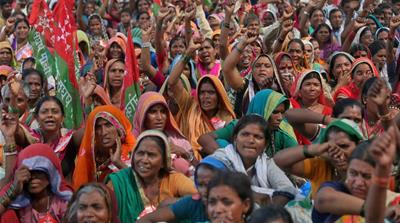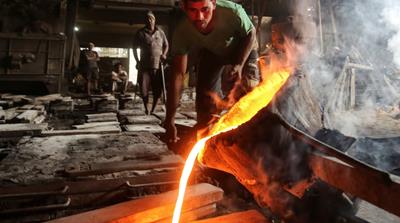Modi 2.0: Can India’s re-elected PM deliver on the economy?
The prime minister will have to boost spending in his second term even as the government’s finances worsen.

Mumbai, India – With promises to spend vast amounts of money, Narendra Modi won a second term as India’s prime minister earlier this month, and by a bigger margin than many had predicted. That was despite two disastrous economic policy moves and a slowdown in growth.
But his electoral victory was probably the easy part. Now, once the pomp and circumstance of his inauguration are over, he and his Bharatiya Janata Party-led coalition will have to deliver on those campaign pledges, just as the government’s finances deteriorate.
Keep reading
list of 4 items‘We need you’: Solomon Islands’ support for US agency’s return revealed
Why are nations racing to buy weapons?
Parallel economy: How Russia is defying the West’s boycott
The party’s 2019 manifesto included a raft of expensive spending pledges, including $1.4 trillion over five years for infrastructure, as well as a significant investment in India’s ailing agriculture sector, and plans to transform India into a global manufacturing hub.
India’s economy does appear to be in need of a boost. Economists at the Central Statistics Office estimated gross domestic product (GDP) grew by 6.6 percent in the last quarter of 2018, down from 7.7 percent in the previous year.
While the country’s GDP data and other statistics have recently come under scrutiny, multiple other indicators also hint at trouble ahead. Car and motorbike sales are down pointing to a decline in consumer spending and foreign direct investment equity inflows are at the lowest in six years.
But analysts say Modi is politically well-positioned to implement a host of major economic reforms, having secured an overwhelming majority in the lower house. The BJP could also capture a majority in the upper house by 2020, as seats become vacant in states that are party strongholds.
But his single biggest problem in carrying out those plans is that his government is already spending more than it receives in revenues, and by a bigger margin than it had predicted. Its so-called fiscal deficit as a proportion to the size of the economy officially stands at 3.4 percent. But one unconfirmed media report this month suggested it could have been as high as 4.5 percent in February.
“In April, the central government announced that it will borrow 4.4 trillion rupees ($63bn), in the first six months of the financial year … that is an astonishing and unprecedented sum of money which shows just how much fiscal pressure the government is under,” Saurabh Mukherjea, chief investment officer and founder of Marcellus Investment Managers told Al Jazeera.
The government received 15 percent less in tax and other revenues than it had projected between April-December 2018. For this reason, “no rational observer” expects the government to go ahead with a spending spree right now, says Mukherjea.
Indian voters “understand this paradigm of pre-election generosity followed by a tightening of the purse strings”, he added.
‘Need of the hour’
Some economists believe policymakers should pursue large spending programmes regardless of a widening fiscal deficit.
“Greater public investment is precisely the need of the hour; there’s no need for such ‘fiscal orthodoxy’,” R Nagaraj, an economist at the Indira Gandhi Institute of Development Research, told Al Jazeera.
Governments should not fear increasing debt in the domestic currency if the funds are used productively, inflation is managed and private investment is stimulated, he added.

Nagaraj points to India’s debt to GDP ratio, which at 67 percent according to IMF data, is “one of the lowest among emerging economies” and significantly below China’s (estimated at 253 percent in June 2018). The government “should not fritter away its political capital, as happened last time but push ahead” with projects that could generate jobs and boost the local economy, Nagaraj added.
An investment of $1.4 trillion in public infrastructure over five years may seem ambitious given the government’s total expenditure in 2018-19 was $352bn. However, “if you include schools, dispensaries, public transport and hospital in the mix too, then this is well within the government’s capacity”, says Mukherjea.
If the government sells roads to private investors, much like they have done with airports, “then gradually this expenditure will look less demanding”, he added.
‘Band-aid solutions’
One of the most visible economic crises of recent years is India’s distressed rural economy.
Tens of thousands of farmers from across the country marched in the capital as part of a series of protests in November 2018. They wanted higher prices for their crops in a market flooded by cheap imports and blocked exports, as the government focussed on taming food inflation.
They also demanded loan waivers to help relieve high levels of personal debt, a big reason why thousands of poor farmers commit suicide every year.
In response, the government pledged an enormous 114 percent increase in funding for the agriculture ministry to help tackle the deepening crisis. This interim budget announcement in February included provisions for a new farmers’ pension scheme, an income support guarantee scheme of $86 a year and interest-free loans up to $1,437.

While in favour of income support schemes to low-income groups, Maitreesh Ghatak, an economics professor at the London School of Economics, calls many of these subsidies “band-aid solutions” that do little to address structural problems.
“What we really need is greater institutional and infrastructural investment, price reforms and insurance to protect against downside risk,” he said.
Ghatak believes current proposals are “propping up mechanisms” that do not encourage farmers to move out of crops that are unprofitable or address why they are not able to receive better prices for their produce in the first place.
‘Complacent’ industrial policy
In its pledge to double the size of India’s economy to $5 trillion by 2025, the government has restated its commitment to its Make In India campaign. Launched in 2014, the programme aims to develop the country’s fragile manufacturing sector.
Unlike many other Asian economies, India is yet to transition from a largely agrarian economy to an industrialised one. Manufacturing sector’s contribution to GDP has stagnated at 15 percent for the past five years. Bangladesh recently overtook India in this respect, according to World Bank data.
India became “complacent” in the late 1990s, says Nagaraj, when policymakers thought a boom in the country’s services sector would leapfrog the workforce from farming to financial services, as governments pinned their hopes on India becoming “the world’s back office”.
Many like him hope the government will concentrate on formulating a new industrial policy and foster a better business environment.

“In 1994, China and India spent roughly the same on [research and development] as a percentage of GDP, but China began to promote technological advancement while we left things to market forces. Today, China spends over three times as much as India,” Nagaraj said.
“This must not continue,” he added, calling for greater state involvement in providing long-term finance for investment, improving local infrastructure and providing technology support.
However, a worldwide economic slowdown and protectionist policies that are shrinking demand for goods in key markets like the United States and parts of Europe could hamper New Delhi’s ambitions to boost manufacturing and double exports.
“Manufacturers will need to reclaim the domestic market,” suggests Nagaraj, adding that this will help India become a less import-dependent economy while supporting the sector’s growth.
A brewing crisis
Markets responded positively to news of a BJP win, expecting it to lead to a period of political stability. The administration has received global recognition for its progressive economic reforms. The introduction of a national value-added tax (VAT) system and new bankruptcy courts helped raise India’s position on the World Bank’s Ease of Doing Business rankings by 65 places in four years.
But a botched implementation of the VAT left many small firms tied up in costly red tape, forcing them to let go of staff.
And Modi’s shock move in 2016 to pull more than 85 percent of cash from circulation – part of an anti-corruption drive – hurt consumers, put the brakes on growth and spooked private investment, as seen in a slowdown in new project proposals.
None of this has hurt the stock market – the main BSE Sensex Index is up nearly 10 percent so far this year. But many economists point to India’s low wage growth and research suggesting rising unemployment as more accurate signs of the poor health of the economy.
Another problem that could trip Modi up in his second term is the country’s privately-owned lenders, so-called shadow banks, or non-banking financial companies. The central bank, The Reserve Bank of India, earlier this month proposed setting minimum financial safety buffers for such companies so they can meet depositors’ demands.
A glaring example of the depth of this crisis was last year’s collapse of Infrastructure Leasing and Financial Services (IL&FS), a large shadow bank. After a series of defaults by the company, the government stepped in and took control of it to prevent the knock-on collapse of other lenders.
Meanwhile, the proportion of borrowers’ missing payments at state banks is rising, posing yet another economic headache for the new government.
“Our version of the Lehman Brothers collapse is happening right now and should be the government’s most pressing concern,” says Mukherjea, referring to the credit vacuum created by the fall of IL&FS.
But despite the government’s rescue of IL&FS, and the RBI injecting $30.3bn into public sector banks, analysts warn that the sector will remain a drain on government finances if structural problems continue to be ignored.
As the new Modi government prepares to take office, it appears his administration may need to spend more time putting out fires, before it can begin building roads.